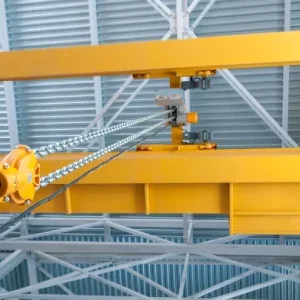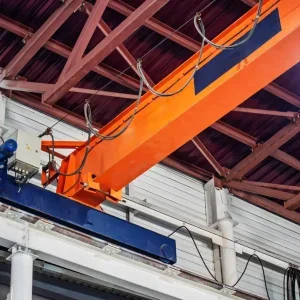The bespoke commission included two 1-ton Demag column-mounted jib cranes and one 5-ton Demag top running single girder bridge crane. Both jibs were standard Demag construction but the 5-ton bridge crane presented the Kristian design team with a unique challenge.
The main obstacle for the bridge design was the requirement that the entire crane structure, including runways, must be freestanding and not be tied into the building’s structure. With a span of 13.7m (45ft) and a runway length of 23.5m (77ft), this was no small freestanding crane.
Brace support beams were required to reinforce the construction in order to stop the columns pulling in towards each other, but due to the lengthy span this could have added additional weight.
In similar installations the design team at Kristian would usually specify a truss bridge beam comprising bracket-type rods to significantly lighten the beam and reduce material costs. However, this requires additional man-hours to implement and can increase the overall cost of a project.
The solution proposed by Ernie Dajavs, project co-ordinator at Kristian, was to construct castellated beams to save time and keep costs down without sacrificing SRI’s design specifications.
Standard I-beams were cut longitudinally in a repeating, tooth-like pattern by an engineering firm in Edmonton using CNC equipment. The two plasma-cut halves were then off-set and re-welded in the castellated pattern in-house at Kristian.
The original beam measured 25cm (10in) in height, but once reconstructed the beam measured more than 37.5cm (15in) without no additional weight.
“It is an estimated 30% lighter,” said Ernie Dajavs. “A truss beam would have taken us two to three days each just to manufacture, while the castellated-style only took about six hours each.”
Although the SRI project marked the first time Kristian has utilised this design in a crane system, it won’t be its last.
“It is an old-fashioned technique and you don’t see it used for cranes much any more,” added Dajavs. “A beam’s strength comes from its depth (height), and by taking weight out and making it taller, it actually ends up making it stronger. It’s a neat way of doing it.”






